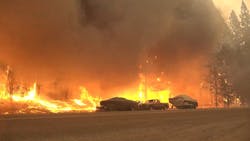Dixie Fire Grows to 2nd-Largest Wildfire in CA History
The Dixie Fire became the second-largest wildfire in state history on Sunday after gobbling an additional 15,000 acres to sprawl across 489,287 total acres in four Northern California counties, Cal Fire said. Containment of the blaze Sunday remained unchanged at 21%.
The huge fire burning across Plumas, Butte, Tehama and Lassen counties has destroyed 404 structures, including the historic Gold Rush town of Greenville, and damaged 27 others, a damage assessment finds. More than 5,000 firefighters were battling the blaze.
RELATED:
- Video: Dixie Fire Devastates Historic CA Fire
- Feds to Wildland Firefighters: Stop Let It Burn Strategy
- High Winds Continue to Fuel Massive CA Wildfire
The Dixie Fire has only reinforced officials' concerns that this season — with severe drought, extreme weather and an abundance of dry fuels in the mix — could rival or exceed last year's record-shattering wildfire year. The already-monstrous fire would have to more than double in size, however, to top the state's largest-ever wildfire: the August Complex, which burned slightly over 1 million acres in 2020.
The Dixie Fire ignited on July 13, possibly sparked by a tree that fell on a Pacific Gas and Electric Co. power line, the company said. PG&E said its equipment also may have ignited the smaller Fly Fire, which merged with the Dixie Fire overnight on July 24.
Cal Fire said it does not consider the Dixie Fire a "fire complex," like the huge August, LNU, SCU and CZU fires caused by lightning sieges last year. According to the U.S. Forest Service, a fire complex is "two or more individual incidents located in the same general area which are assigned to a single incident commander or unified command."
That makes Dixie the largest non-complex fire in California history, according to Cal Fire.
The western part of the blaze saw moderate overnight activity Saturday as fuel moisture levels remained historically low. Shade provided by smoke from the state's fires set the stage for reduced fire intensity and increased potential for firefighters to make progress building containment lines.
Gov. Gavin Newsom toured what was once Greenville on Saturday and tweeted, "Our hearts ache for this town."
To the east, smoke significantly reduced visibility, making driving hazardous for weekend firefighting crews. Clearing skies near Moonlight Peak in Plumas County led to more dynamic fire behavior.
Crews worked along the fire's edge, cutting hand lines and using fire engines to contain the fire, said Serena Baker, Dixie Fire East Zone public information officer. The lifting of smoke later Sunday and expected winds were likely to make it more dangerous for crews to be near the edge of the fire.
"Today unfortunately is kind of the return of a drying trend in the forecast," along with warmer temperatures and gusty southwest winds, Baker said Sunday.
But that better visibility also allows for airplanes and helicopters to attack the blaze from the air, she said.
Fire managers were shifting personnel to cover priority areas, including protecting homes in Crescent Mills and Hunt Canyon ( Plumas County) and Westwood ( Lassen County).
Baker said crews had already cut fire lines near Highway 147 on the eastern side of Lake Almanor and moving toward Westwood. In Crescent Mills, south of Greenville, fire crews were burning off fuels that could feed the blaze, laying water hoses in some neighborhoods, and staging sprinklers and water pumps for the potential of fire threatening structures there, she said.
Mandatory evacuations were in place south of Highway 44, including in Silver Lake, Juniper Lake and the Caribou Wilderness Area Zone. Officials urged everyone to immediately leave the unpopulated area south of Mountain Meadows Reservoir from Hamilton Branch waterway east to the Lassen- Plumas County line.
The Red Cross announced Sunday it was opening a shelter for evacuees at Shasta College in Redding. In Lassen County, shelters at Lassen High School and Lassen Community College are available, and in Plumas County, Springs of Hope Christian Fellowship, Portola Station Baptist Church and Holy Family Church are all open to evacuees. Campsites are also available for those fleeing the fire in Lassen National Forest, including Eagle Lake and Hat Creek.
Firefighters continued to make progress against the River Fire near Colfax ( Placer County), which threatened a number of residential areas. At 2,600 acres, the blaze was 65% contained early Sunday after firefighters expanded containment lines, officials said. Inspection teams were evaluating damage.
The River Fire had destroyed 88 structures and damaged 20 by Sunday evening. Three people, including civilians and fire personnel, have been injured.
Emma Talley and Chase DiFeliciantonio are San Francisco Chronicle staff writers. Email: [email protected],
[email protected] Twitter: @ChaseDiFelice, @EmmaT332
___
(c)2021 the San Francisco Chronicle
Visit the San Francisco Chronicle at www.sfchronicle.com
Distributed by Tribune Content Agency, LLC.
